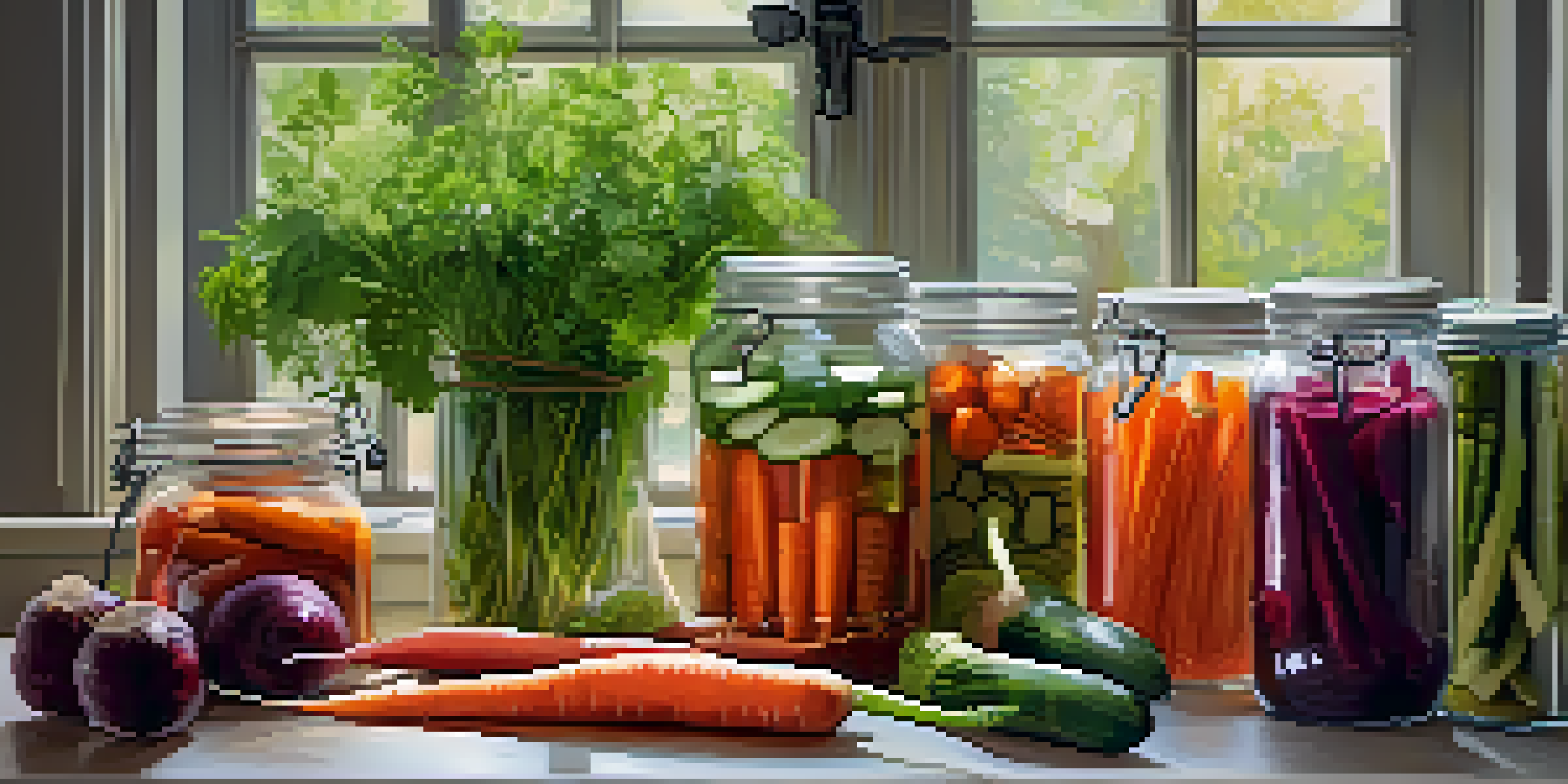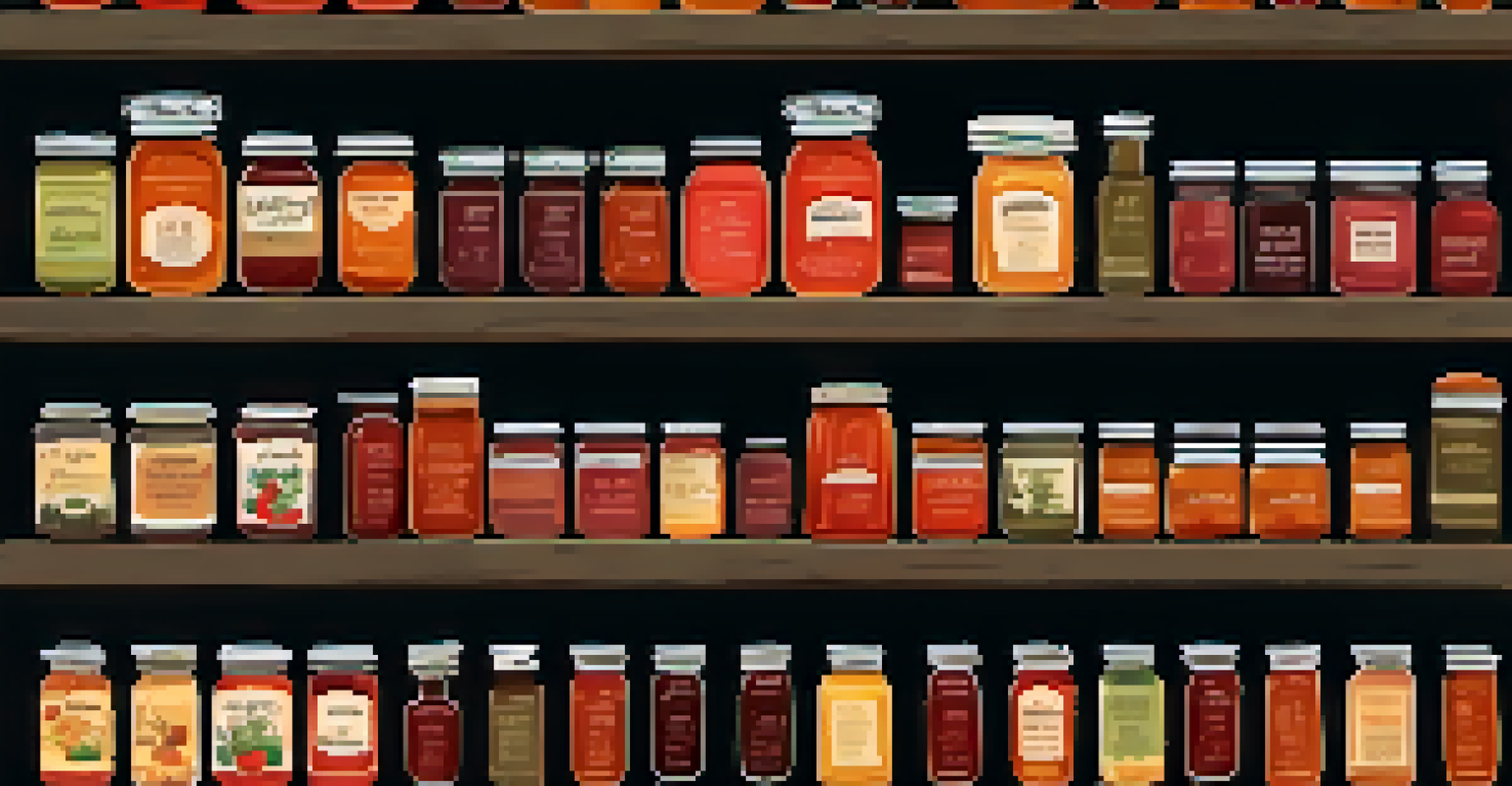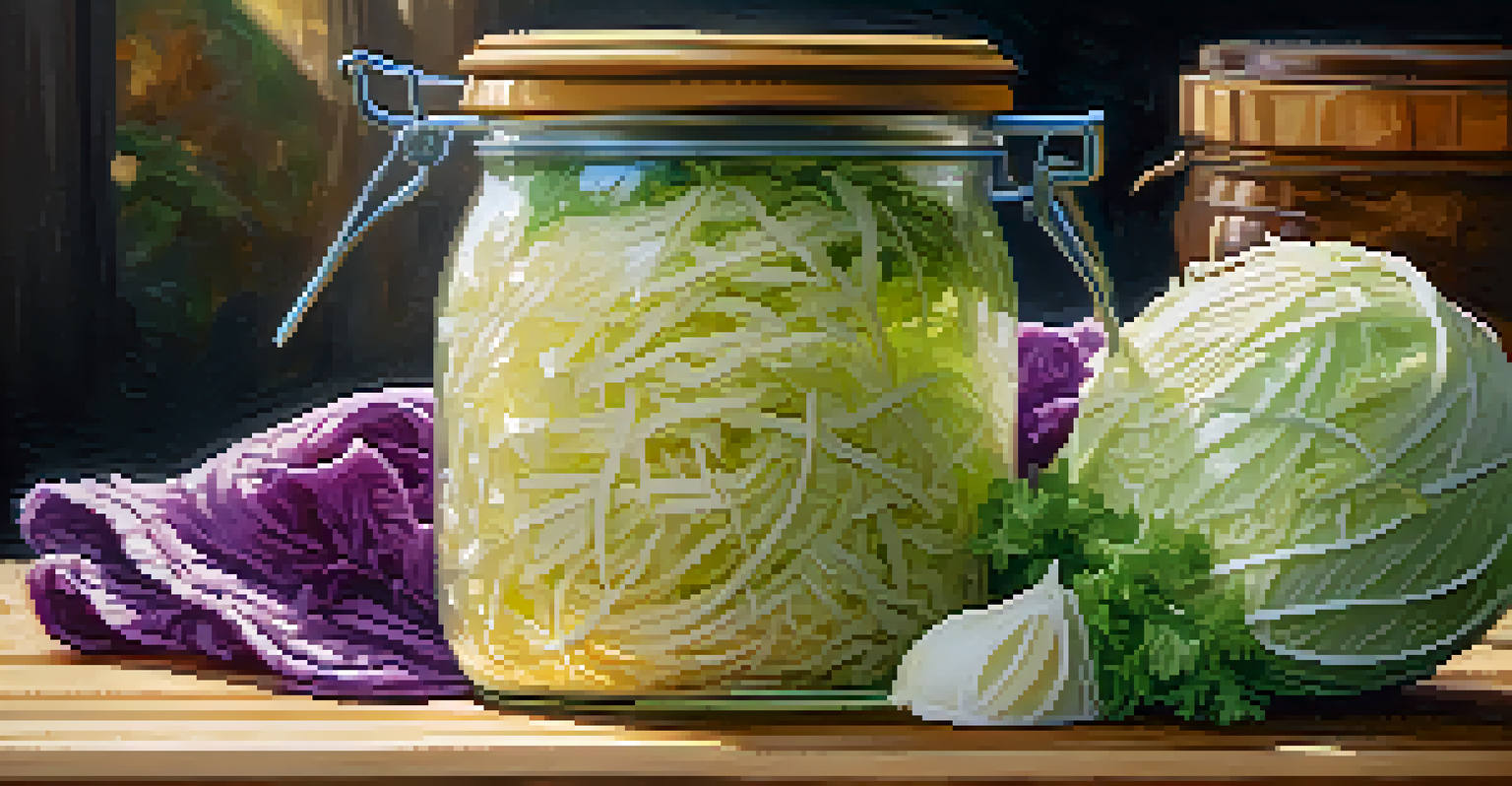Historical Preserving Techniques: Recipes for Modern Use

The Art of Pickling: A Timeless Preservation Method
Pickling is one of the oldest food preservation techniques, dating back thousands of years. It involves immersing foods in a solution of vinegar, salt, and spices, which creates a tangy flavor and prevents spoilage. From cucumbers to beets, almost any vegetable can be pickled, making this method both versatile and delicious.
Preservation is a way of keeping the essence of the season alive, allowing us to savor its flavors even when the snow falls.
Today, pickling has made a comeback, not just for preserving but also for enhancing flavors in modern dishes. Imagine adding a zesty pickled onion to a gourmet burger or incorporating pickled radishes into a fresh salad. The possibilities are endless, and the process is quite simple, perfect for both seasoned cooks and beginners.
To get started, try a basic pickling recipe: combine equal parts vinegar and water, add salt, sugar, and your favorite spices, and pour over prepared vegetables. Let them sit in the fridge for a few days, and you'll have your own homemade pickles to enjoy!
Canning: A Safe Way to Store Seasonal Bounty
Canning is a method that allows you to preserve fruits, vegetables, and even meats by sealing them in jars and heating them to kill bacteria. This technique was developed in the early 1800s and has been a staple for home cooks looking to store seasonal produce for year-round enjoyment. The beauty of canning lies in its ability to capture the essence of the harvest.

With canning, you can create everything from sweet jams to savory sauces, ensuring you have your favorite flavors available even in the off-season. It’s a wonderful way to reduce food waste and enjoy the taste of summer in the dead of winter. Plus, there’s something incredibly satisfying about seeing rows of colorful jars lining your pantry.
Pickling Adds Flavor and Longevity
This ancient technique not only preserves vegetables but also enhances their taste, making dishes more exciting.
To begin canning, you'll need basic supplies like jars, lids, and a canning pot. Start with easy recipes, such as strawberry jam or tomato sauce, to build your confidence, and soon you’ll be experimenting with a variety of ingredients and flavors.
Fermentation: Transforming Foods with Microbes
Fermentation is a fascinating process that uses beneficial bacteria and yeast to transform food, creating unique flavors and textures. This ancient technique not only preserves food but also enhances its nutritional profile, making it a popular choice among health-conscious eaters today. Think yogurt, sauerkraut, and kombucha—each packed with probiotics that support gut health.
Eating seasonally is a reminder that food is a gift of nature, meant to nourish us in harmony with the earth.
Incorporating fermented foods into your diet can be both fun and rewarding. You can easily create your own ferments at home, allowing you to experiment with flavors and ingredients. For instance, making your own kimchi or pickled vegetables can elevate a simple meal to something extraordinary.
To start fermenting, try a basic sauerkraut recipe: finely shred cabbage, mix with salt, and pack it tightly into a jar to ferment for a week or two. The result will be a tangy, crunchy side dish that pairs well with many meals and adds a probiotic boost to your diet.
Preserving with Sugar: The Sweet Side of Preservation
Using sugar to preserve fruits has been a cherished technique for centuries. By cooking fruits with sugar, you create jams, jellies, and conserves that not only taste delightful but also have a long shelf life. This method captures the sweetness and flavor of ripe fruits, allowing you to enjoy them long after their season has passed.
While traditional recipes often call for white sugar, you can experiment with alternatives like honey or maple syrup to create unique flavor profiles. Imagine spreading homemade peach jam made with local honey on your breakfast toast—it's a delicious way to start the day!
Canning Captures Seasonal Harvests
Canning allows you to store the freshness of seasonal produce, ensuring you can enjoy favorite flavors year-round.
To make a basic fruit preserve, simply cook your chosen fruit with sugar until it reaches a gel-like consistency. Pour it into sterilized jars, seal, and store in a cool, dark place. You'll have a delightful treat that can brighten up your morning routine or serve as a thoughtful gift.
Drying: Concentrating Flavors and Nutrients
Drying is one of the simplest methods of food preservation that removes moisture to inhibit the growth of spoilage-causing microorganisms. This technique has been used for thousands of years, allowing people to store fruits, vegetables, and herbs for extended periods. Dried foods make for easy snacks and are perfect for adding depth to various dishes.
From sun-dried tomatoes to dried apricots, the options are plentiful. You can easily dry foods at home using an oven or a food dehydrator, making it accessible for anyone who wants to try their hand at preserving. Plus, dried foods are lightweight and portable, making them ideal for hikes or road trips.
To get started, slice your fruits or vegetables thinly, arrange them on a baking sheet, and place them in a low-temperature oven until they’re fully dried. Store them in airtight containers, and you’ll have a nutritious snack that’s perfect for any occasion.
Root Cellaring: Nature’s Refrigerator
Root cellaring is an ancient method of preserving vegetables by storing them in a cool, dark, and humid environment. This technique takes advantage of the natural conditions of the earth to keep produce fresh for months. Foods like carrots, potatoes, and apples thrive in this environment, making it a sustainable option for home gardeners.
When done correctly, root cellaring can significantly extend the life of your harvest without the need for electricity or complicated methods. It’s a nod to simpler times when people relied on the earth’s natural resources to sustain themselves through the colder months. Imagine enjoying crisp, sweet carrots in the middle of winter, harvested just before the frost.
Seasonal Eating Enhances Preservation
Focusing on seasonal produce not only improves flavor and nutrition but also promotes sustainable food practices.
To create your own root cellar, choose a cool, dark area in your home or build a small outside structure. Layer vegetables in boxes with sawdust or sand to absorb moisture, and check regularly for spoilage. This method not only keeps your produce fresh but also connects you to the rhythms of nature.
The Importance of Seasonal Eating in Preservation
One of the core principles of food preservation is the concept of eating seasonally. By focusing on seasonal produce, you not only enjoy better flavors and nutrients but also reduce the environmental impact associated with out-of-season food transportation. Seasonal eating pairs beautifully with preservation techniques, as it encourages you to make the most of what’s available.
When you preserve seasonal fruits and vegetables, you’re essentially capturing the peak of their flavor and nutrients for later enjoyment. This philosophy can help you develop a deeper connection to your food and a greater appreciation for the cycles of nature. Picture a summer filled with fresh strawberries, and then savoring their flavor throughout winter in the form of jam.

To embrace seasonal eating, visit local farmers' markets or join a community-supported agriculture (CSA) program. This way, you’ll discover new ingredients to try and preserve, creating a more sustainable food journey that respects the land and the seasons.